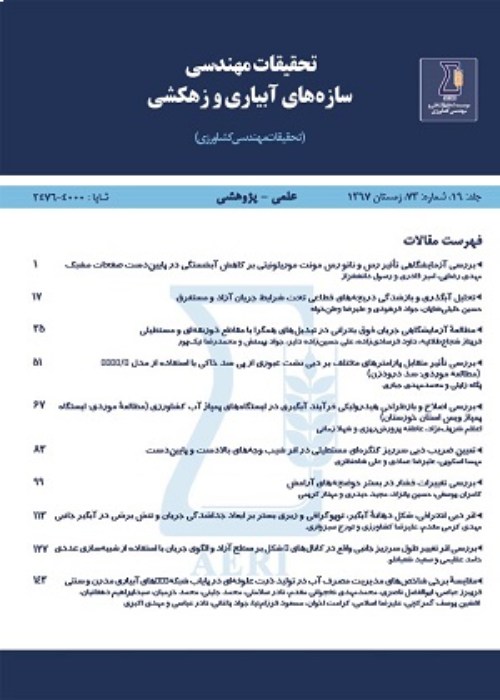Combined Method of Response Surface and Meta-Exploration in Updating the Numerical Model of Unsteady Flow in River Network, Case Study: Garmabadr-Ziqan River
Nowadays, numerical modeling is known as a powerful method and tool in investigating practical phenomena. So that this method is used in many fields of engineering. Although the numerical model of an engineering problem is usually prepared based on several simplifying assumptions, it is possible that this numerical model does not reflect all aspects of the real problem and is not able to show the real behavior in reality. Direct updating methods use the analytical solution of the problem for this purpose, although these methods specify the necessary corrections without the need to repeat calculations and in one step, but in most cases such corrections do not have a physical meaning in reality but iteration-based updating methods require sensitivity analysis of the effective parameters in the problem in order to find the impact of each of them. One of the solutions to deal with the time-consuming problem of multiple re-analyses in numerical models prepared by commercial software during model updating based on sensitivity analysis is to replace the numerical model with an approximate representative model known as meta-models. The response surface method is one of the common methods for building such meta-models. The response surface technique is actually a test design method to select the design parameters in the experiment with the aim of optimizing some system response functions. From this point of view, the research regarding the response of the network of open channels to the arrival of the flood wave and predicting the characteristics of the flow in the branches of the network can be the solution to minimize the damages caused by it.
In this research, in order to update the numerical model of unsteady flow in the network of open channels by using the combined method of response surface and meta-exploration methods, a branch of the Garmabadr River (Ziquon) has been selected, and the desired data has been prepared and sorted. have been Hec-Ras software has been used as a numerical method. Neural network is also chosen for simulating the numerical method so that the desired parameters can be optimized in the process of using the genetic algorithm method. This area is located in the northern part of Iran and in the northeast of Tehran province. The geographical coordinates include longitude 51 degrees 32 minutes to 51 degrees 38 minutes and latitude 35 degrees 51 minutes to 35 degrees 58 minutes. MATLAB software has been used to build a meta-model or an alternative model. MATLAB is a software that can be called the language of mathematics and modern engineering sciences.
As it is clear from the results of the Hec-Ras program, the discharge of stations number 13 and 22 is equal to 308.03 and 27.89 cubic meters per second, respectively. The estimation error is equal to the difference between the estimated flow rate and the observed flow rate, which is 18.03 and 2.11 cubic meters per second, respectively. The percentage of the estimation error is equal to the ratio of the estimation error to the observed value is equal to 6.2% and 7%, respectively, which is an acceptable value for this research, and this result shows the appropriate performance of the genetic algorithm for optimizing the flow simulated by It shows the neural network, on the other hand, the low percentage of error also determines the accuracy of the intended program. As a result, the error of the genetic program is at an optimal level. As it is known, Manning's coefficients are very important and influential parameters in the behavior of the flow, the change in which causes significant changes in the simulation results. The effect of this uncertainty on the performance of numerical methods was clearly identified in this research. As a result, examining inputs that have inherent uncertainty and determining their appropriate values is a suitable solution for improving numerical methods.
Genetic algorithm is a powerful method to determine the values of effective parameters in simulated flow performance, and its combination with neural network is a powerful tool for engineering purposes, including the analysis of the behavior of open channels, whose fast convergence is a strong point to choose in these problems. in similar cases.
Manning's coefficients are very important and influential parameters in the simulated flow behavior, with a small change in it, the simulated model undergoes significant dispersion, which should be considered in the analysis process so that the results are not significantly different from reality.
Optimizing an effective parameter in simulated flow behavior is an erosive and time-consuming process, and the use of neural network becomes much faster and more reliable due to the high convergence speed of this process.
- حق عضویت دریافتی صرف حمایت از نشریات عضو و نگهداری، تکمیل و توسعه مگیران میشود.
- پرداخت حق اشتراک و دانلود مقالات اجازه بازنشر آن در سایر رسانههای چاپی و دیجیتال را به کاربر نمیدهد.


